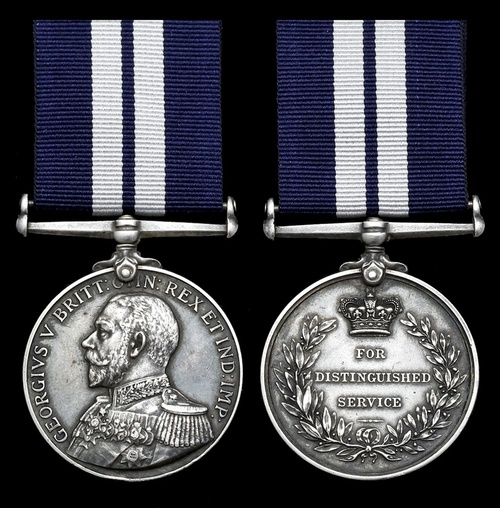
Auction: 17002 - Orders, Decorations and Medals
Lot: 384
A very early - and consequently rare - Great War Q-Ship action D.S.M. awarded to Able Seaman P. H. Hart, Royal Navy, who was decorated for his gallant deeds in the armed smack Pet in August 1915
Distinguished Service Medal, G.V.R. (J. 15389 P. H. Hart, A.B., H.M. Smk. Pet), edge bruise, very fine
D.S.M. London Gazette 19 November 1915:
'The following awards have also been approved.'
Percy Harold Hart was born in Edmonton, London on 1 October 1895 and entered the Royal Navy as a Boy 2nd Class in January 1912.
Advanced to Able Seaman in the torpedo gunboat H.M.S. Halcyon on the outbreak of hostilities in August 1914, he was an early entrant into the clandestine world of Q-Ship operations, in his case aboard the ex-fishing smack Pet in the summer of 1915.
The first 'victory' obtained by an unassisted Q-Ship took place on 24 July 1915 when the Prince Charles, commanded by Lieutenant Mark-Wardlaw, D.S.O., sank U-36. In the following month, on the 14th, an even smaller converted fishing smack, renamed Inverlyon, engaged and destroyed UB-4 near Great Yarmouth. Like Pet, Inverlyon was an unpowered sailing ship fitted with a small 3-pounder gun.
As far as can be ascertained, Pet's action, less than 10 days later, was the next Q-Ship victory claimed by the Admiralty. The following official report - stamped 'SECRET' - was submitted by the C.O. of Lowestoft naval base on 24 August 1915:
'In confirmation of my telegram No. 596 of today, be pleased to inform Their Lordships that an enemy submarine was successfully sunk by the armed smack Pet yesterday (Monday), when about six miles S. by E. of Smith's Knoll Spar Buoy.
The submarine was first sighted at 9.40 a.m. at a distance of 1000 yards, carrying a lug sail, and fired a dozen rounds from a quick firing gun, evidently to order the smack's crew into its boat. The smack replied with nine rounds, registering three hits on the conning tower, when the submarine dived rapidly. The submarine reappeared at 10.20 a.m. at 1100 yards with a pole up to send wireless messages. Four rounds were fired at her, registering one hit, when she submerged. The submarine reappeared at a distance of 100 yards and fired a torpedo at the smack, missing by about 12 feet, and on this occasion six rounds were fired from the smack, four hits being registered, when the submarine heeled over at an angle of 45 degrees to starboard, then sank nose down in 25 fathoms, her planes being visible as her stern disappeared. The submarine was about 130 feet long and had two periscopes.
I desire to call attention to the skill and courage shown by Petty Officer George Moore Lee, G.L. 2, PO. 190273, in this matter, he being in entire command, and I consider conducted the action with great judgment under very exciting conditions, it being at first difficult for him to decide whether he should open fire on the submarine at such a range, having regard to the orders which I gave him that a submarine was only to be engaged when there was an almost certainty of sinking her, as I did not desire information that smacks were armed to be obtained by the enemy. However, it appears that, on each occasion that the smacks have been in action, they have been able to sink the enemy with no survivors to tell the tale, though it is possible that, in the last case, the submarine being fitted with wireless, she got a signal through when she came up with her wireless mast showing.'
Postscript
Hart, who was advanced to Leading Seaman in August 1916, was invalided ashore in August 1919, suffering from neurasthenia, a nervous condition often associated with shell-shock; sold with copied research, including relevant T.N.A. references.
Subject to 20% VAT on Buyer’s Premium. For more information please view Terms and Conditions for Buyers.
Estimate
£800 to £1,000




